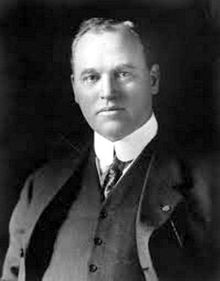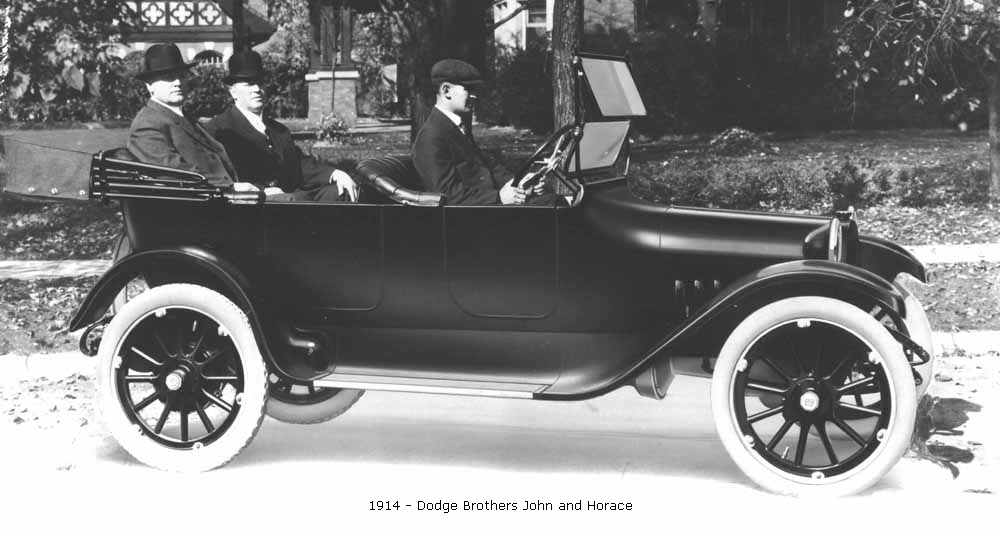John Dodge
 John Francis Dodge (1864 – 1920) was an American automobile manufacturing pioneer and co-founder of Dodge Brothers Company. He was born in Niles, Michigan. John and his younger brother, Horace, were inseparable as children and as adults. The origins of the Dodge family lie in Stockport, England, where their ancestral home still stands. In 1886 the Dodge family moved to Detroit, where John and Horace took jobs at a boiler maker plant.
John Francis Dodge (1864 – 1920) was an American automobile manufacturing pioneer and co-founder of Dodge Brothers Company. He was born in Niles, Michigan. John and his younger brother, Horace, were inseparable as children and as adults. The origins of the Dodge family lie in Stockport, England, where their ancestral home still stands. In 1886 the Dodge family moved to Detroit, where John and Horace took jobs at a boiler maker plant.
In 1894 they went to work as machinists at the Dominion Typograph Company in Windsor, Ontario, Canada. While John was the sales-minded managerial type, his brother Horace was a gifted mechanic and inveterate tinkerer. John arranged a deal for the brothers to join with a third-party investor to manufacture bicycles. Within a few years, they sold the bicycle business and in 1900 used the proceeds of the sale to set up their own machine shop in Detroit.
In their first year of business the Dodge brothers’ company began making parts for the automobile industry. In 1902 the Dodge brothers won a contract to build transmissions for the Olds Motor Vehicle Company upon which they built a solid reputation for quality and service. However, the following year they turned down a second contract from Olds to retool their plant to build engines for Henry Ford in a deal that included a share position in the new Ford Motor Company. By 1910, John Dodge and his brother were so successful they built a new plant in Hamtramck, Michigan.
From 1903 – 1913, the Dodge brothers’ business was a Ford Motor Company supplier, and John worked as vice president of the Ford company. He left Ford in 1913, and in 1914 he and Horace formed Dodge Brothers to develop their own line of automobiles. They began building motor trucks for the United States military during the arms buildup for World War I, and in October 1917 they produced their first commercial car. At war’s end, their company produced and marketed both cars and trucks.
Because of his temper and often crude behavior, Dodge was seen as socially unacceptable to most of the well-heeled elite of Detroit. Nevertheless, his wealth made him an influential member of the community and he became active in Republican Party politics in Michigan.
In January 1920, Dodge and Horace contracted Spanish flu and pneumonia while in New York City. Dodge died on January 14, 1920 at the Ritz-Carlton, aged 55. He was interred in the Egyptian-style family mausoleum in Detroit’s Woodlawn Cemetery guarded by two Sphinx statues.
John Dodge’s newborn daughter Anna Margaret died of the measles before age five. His son Daniel drowned in the waters off Manitoulin Island after falling overboard while being transported to hospital following an accident involving dynamite. He had just recently married, at age 21.
Horace Elgin Dodge, Sr.
 Horace Elgin Dodge, Sr. (1868 – 1920) was an American automobile manufacturing pioneer and co-founder of Dodge Brothers Company. He was born in Niles, Michigan, on May 17, 1868. In 1886, the Dodge brothers moved to Detroit, Michigan, where they took jobs at a boilermaker plant. In 1894 they went to work as machinists at the Canadian Typograph Company across the Detroit River in Windsor, Ontario. In 1896, Horace Dodge married Anna Thompson. The couple had a son, Horace Jr., and a daughter, Delphine.
Horace Elgin Dodge, Sr. (1868 – 1920) was an American automobile manufacturing pioneer and co-founder of Dodge Brothers Company. He was born in Niles, Michigan, on May 17, 1868. In 1886, the Dodge brothers moved to Detroit, Michigan, where they took jobs at a boilermaker plant. In 1894 they went to work as machinists at the Canadian Typograph Company across the Detroit River in Windsor, Ontario. In 1896, Horace Dodge married Anna Thompson. The couple had a son, Horace Jr., and a daughter, Delphine.
While brother John Dodge was the sales oriented managerial type, Horace was a gifted mechanic and inveterate tinkerer. Using a dirt-proof ball bearing Horace invented and patented, in 1897 John arranged a deal for them to join with a third party investor to manufacture bicycles. Within a few years, they sold the business and in 1901 used the proceeds of the sale to set up their own machine shop in Detroit. During their first year in business the Dodge brothers’ company began making parts for the automobile industry.
In 1902, they won a contract to build transmissions for the Olds Motor Vehicle Company upon which they built a solid reputation for quality and service. However, the following year they turned down a second contract from Olds (Oldsmobile) to retool their plant to build engines for Henry Ford in a deal that included a share position in the new Ford Motor Company. By 1910, Horace Dodge and his brother were so successful they built a new plant in Hamtramck, Michigan.
For ten years, the Dodge brothers’ company was supplier to Ford. In 1913 the Dodge brothers terminated their Ford contract and devoted their energies toward producing a Dodge automobile. They began building motor trucks, ambulances and other vehicles for the United States military during the arms buildup for World War I and in October 1917 they produced their first commercial car. At war’s end, their company manufactured and marketed both cars and trucks.
Despite their wealth and growing influence in the business community, the Dodge brothers’ crude manners and aggressive conduct made them socially unacceptable to most of the wealthy Detroit. Horace and Anna Dodge became major benefactors of the new Detroit Symphony Orchestra and would play a key role in the construction of Orchestra Hall.
Horace Dodge’s keen interest in speedboats and yachting, and the vessel’s engines led him to establish a marine division as part of their automotive business. He purchased several motor yachts, each larger and more luxurious than the previous. The last, named the Delphine for his daughter, was a 257.8-foot (78.6 m) vessel. Construction commenced in 1920 and was completed in 1921, after his death. Horace contracted the Spanish flu and died from complications resulting in pneumonia and cirrhosis of the liver on December 1920, at the age of 52. He was interred with his brother in the same mausoleum. Horace E. Dodge, Jr. died in 1963 at age 63. His widow outlived him by fifty years, her death in 1970.


You must be logged in to post a comment.